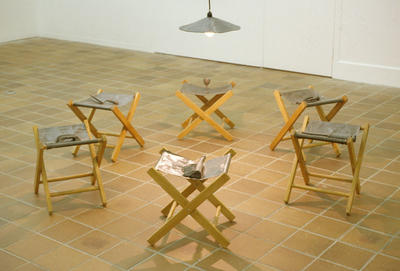Red Legs
-
Greer Twiss
b.1937

Title
Red Legs
Details
| Production Date | 1968 |
|---|---|
| Collection(s) | Collection Govett-Brewster Art Gallery, New Plymouth. Purchased with the assistance of Taranaki Savings Bank in 1970. |
| Accession Number | 70/8 |
| Media | Painted fibreglass and hardboard |
| Measurements | 708 x 600 x 2310mm |
About
Greer Twiss is an artist who is acutely aware of the world around him. His artworks are designed to jolt or tease the viewer into paying closer attention, often using humour to provoke curiosity. Red Legs I is theatrical in fire-engine red; a bold paint job which is half glossy seduction and half suggestive of an alarming medical mishap. It is a surreal tableau — two legs have been abruptly truncated mid-stride, as if by a horizontally-sweeping laser. The figure’s shadow, which is still intact, seems to have not yet realised the fact of its body’s dismembered state.
Red Legs I is a sculpture which operates through the logic of a painting or photograph. The figure has been ‘cropped’ by an invisible frame. In the manner of a painter, Twiss has provided a cast shadow which asks us to imagine the figure extending into the invisible territory beyond the edge of the frame. Of course, because the work is three-dimensional, this artificial shadow is often obliged to compete with actual shadows cast by gallery lighting. Twiss plays with the interchange between the two- and three-dimensional, a point which is reiterated by his use of a glossy, red surface. While the lustre emphasises the musculature of the legs, the figure’s shadow is as smooth and flat as a pool of recently-spilled paint.
The playful aspects of Red Legs I, however, counterpose the psychological violence implicit in Twiss’ use of bodily parts. Fragmented, the body becomes an uncanny reminder of its own object-ness. The fact that the legs are cast from life, a process which literally re-makes an animate body as an inanimate object, reinforces the tension between the body seen as an object among objects, as well as a means of navigating and perceiving the world.
